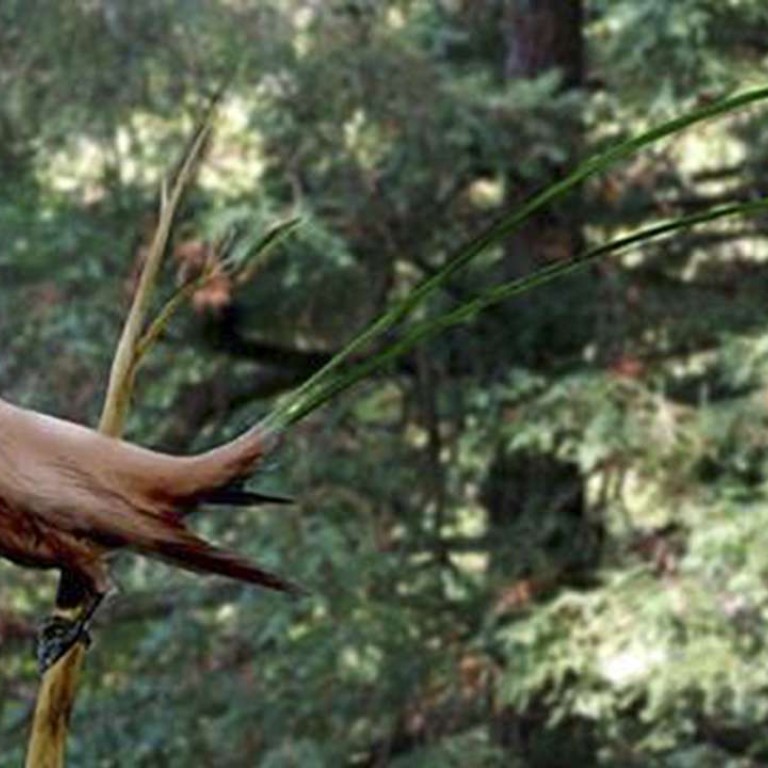
How do birds fly? Chinese feather fossil may hold key to 130-million-year-old question
Discovery of protein in ancient avian specimen could help scientists reconstruct properties of early birds and animals
Researchers have identified a protein essential to flight in the fossilised feathers of a 130-million-year-old bird fossil, according to a China-led international study.
The discovery of the protein, which is also found in modern avian species and gives feathers elasticity, suggests that birds mastered the art of flying before the extinction of dinosaurs, which is believed to have contributed to their survival until today.
The molecular structure of beta-keratin, a protein that contributes to the formation of a protective layer over bird feathers, could have been preserved under certain conditions in the long process of fossilisation, according to a paper released by the Proceedings of the National Academy of Sciences in the United States on Tuesday.

“This is the oldest report of ultrastructure consistent with beta-keratin from an Early Cretaceous bird feather,” the authors said in the paper.
The team, led by Dr Pan Yanhong, a researcher with the Nanjing Institute of Geology and Palaeontology at the Chinese Academy of Sciences in Jiangsu, examined a fossil specimen of Eoconfuciusornis, an extinct bird species found in the Jehol deposit in Liaoning province.
Eoconfuciusornis is also known as the early Confucius bird in Chinese. With a long tail and pointed, toothless beak, the bird is one of the oldest avian species discovered in China.
Eoconfuciusornis was able to fly high and fast, unlike the earliest birds such as the Archaeopteryx discovered in Europe, which had a questionable capacity to leave the ground.
The discovery by Pan’s team settled a long debate on whether the molecular structure of animal skin tissue could be preserved in extremely old fossil records.
Calcium, they suspected, might have facilitated ultrastructural and molecular preservation of the feathers by stabilising them at the molecular level before they could completely degrade.
“We are excited about the discovery because it will shed light on many issues,” Pan told the South China Morning Post.

The discovery would, for instance, help scientists reconstruct some physical properties of feathers on ancestral birds or dinosaurs, such as colour, she said.
In recent years, some research teams had found “microbody” structures that they believed were melanosomes, the parts of a cell that contain pigment in an animal’s skin or feathers. Using trace chemicals found in these structures, the researchers recreated the colours of some ancient creatures.
But these studies were not without controversy. One major point of debate was that the structures appeared identical to imprints left behind by bacteria. The failure to detect keratin on fossil records in previous studies also strengthened the suspicion that melanosome-like structures were created by microorganisms during the process of decomposition.
Pan’s study not only found the keratin but also ruled out the possibility that the melanosome-like structures were generated by bacteria. The melanosomes in the ancestral bird were protected by keratin layers in the same way as in modern birds.
The Jehol deposit is ranked as one of the biggest fossil sites in the world, with many species of animals and plants preserved in similar conditions to those of their lifespans. The study raised hope that more skin tissue would be discovered in fossil records.
“We can use the same technology to study other animals, such as dinosaurs,” Pan said.
The breakthrough was achieved with a multidisciplinary approach. The researchers used a high-definition electron microscope together with immunohistochemistry, a technique used by biologists to detect antigens in the cells of a tissue, to rule out the possibility that the structures were produced by bacteria.
“The biggest challenge occurred during the preparation of samples,” Pan said. “We must remove many unwanted materials to reveal the keratin proteins, and for the job I borrowed some techniques used in the study of ancient human DNA.”
The study came at a cost. The samples, each smaller than a grain of rice, had to be removed from various parts of the fossil, causing irreparable damage to the specimen.
Although the Jehol deposit produced a large number of fossils, the researchers said they hoped to minimise the damage to them.

